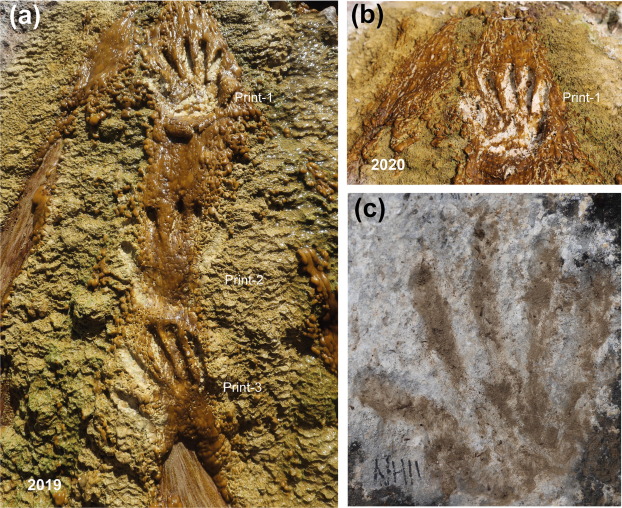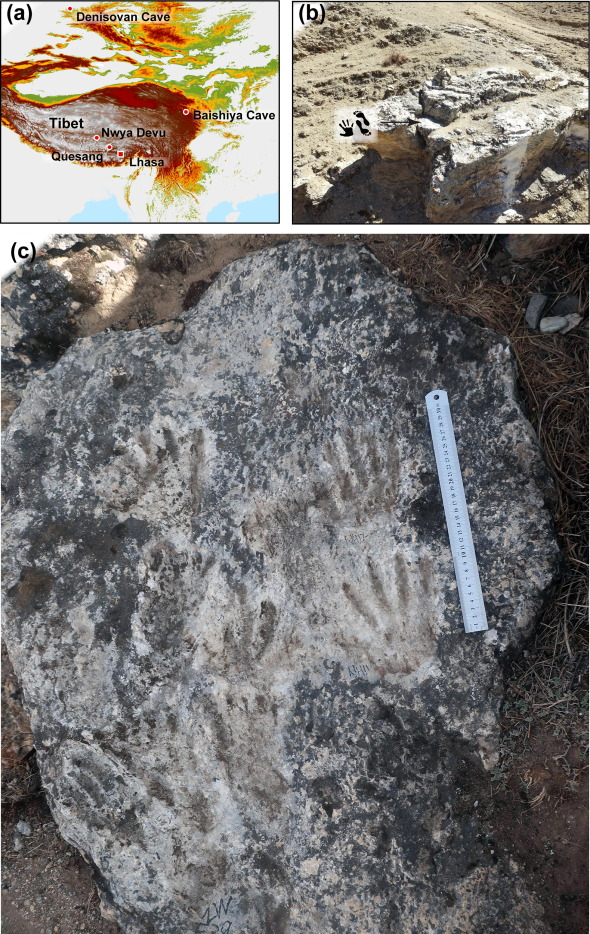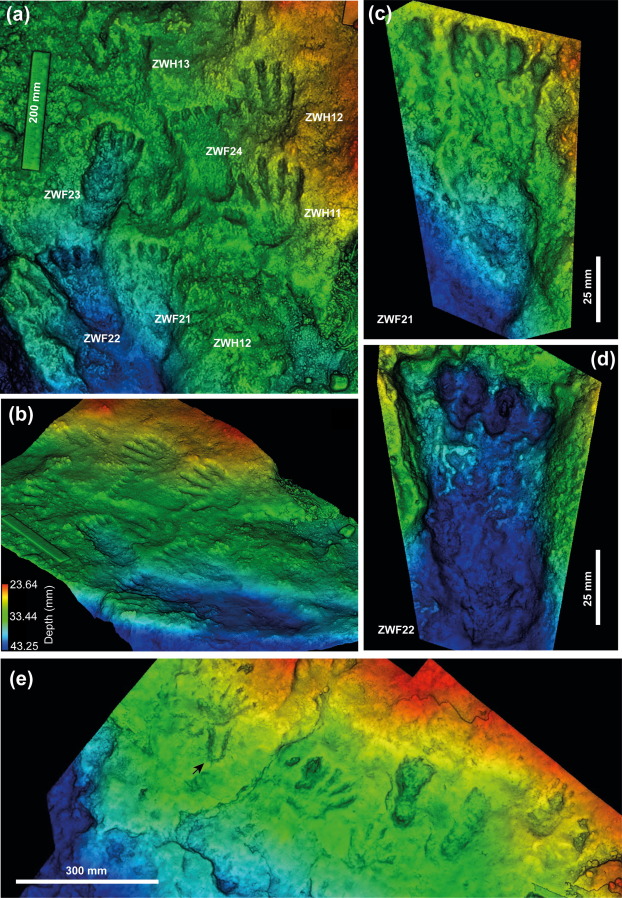
Wet cement triggers a primal impulse, particularly in children.
It’s so tempting to inscribe a pristine patch of sidewalk with a lasting impression of one’s existence.
Is the coast clear? Yes? Quick, grab a stick and write your name!
No stick?
Sink a hand or foot in, like a movie star…
…or, even more thrillingly, a child hominin on the High Tibetan Plateau, 169,000 to 226,000 years ago!

Perhaps one day your surface-marring gesture will be conceived of as a great gift to science, and possibly art. (Try this line of reasoning with the angry homeowner or shopkeeper who’s intent on measuring your hand against the one now permanently set into their new cement walkway.)
Tell them how in 2018, professional ichnologists doing fieldwork in Quesang Hot Spring, some 80 km northwest of Lhasa, were over the moon to find five handprints and five footprints dating to the Middle Pleistocene near the base of a rocky promontory.
Researchers led by David Zhang of Guangzhou University attribute the handprints to a 12-year-old, and the footprints to a 7‑year-old.
In a recent article in Science Bulletin, Zhang and his team conclude that the children’s handiwork is not only deliberate (as opposed to “imprinted during normal locomotion or by the use of hands to stabilize motion”) but also “an early act of parietal art.”

The Uranium dating of the travertine which received the kids’ hands and feet while still soft is grounds for excitement, moving the dial on the earliest known occupation (or visitation) of the Tibetan Plateau much further back than previously believed — from 90,000–120,000 years ago to 169,000–226,000 years ago.
That’s a lot of food for thought, evolutionarily speaking. As Zhang told TIME magazine, “you’re simultaneously dealing with a harsh environment, less oxygen, and at the same time, creating this.”
Zhang is steadfast that “this” is the world’s oldest parietal art — outpacing a Neanderthal artist’s red-pigmented hand stencil in Spain’s Cave of Maltravieso by more than 100,000 years.
Other scientists are not so sure.
Anthropologist Paul Taçon, director of Griffith University’s Place, Evolution and Rock Art Heritage Unit, thinks it’s too big of “a stretch” to describe the impressions as art, suggesting that they could be chalked up to a range of activities.
Nick Barton, Professor of Paleolithic Archeology at Oxford wonders if the traces, intentionally placed though they may be, are less art than child’s play. (Team Wet Cement!)
Zhang counters that such arguments are predicated on modern notions of what constitutes art, driving his point home with an appropriately stone-aged metaphor:
When you use stone tools to dig something in the present day, we cannot say that that is technology. But if ancient people use that, that’s technology.
Cornell University’s Thomas Urban, who co-authored the Science Bulletin article with Zhang and a host of other researchers shares his colleagues aversion’ to definitions shaped by a modern lens:
Different camps have specific definitions of art that prioritize various criteria, but I would like to transcend that and say there can be limitations imposed by these strict categories that might inhibit us from thinking more broadly about creative behavior. I think we can make a solid case that this is not utilitarian behavior. There’s something playful, creative, possibly symbolic about this. This gets at a very fundamental question of what it actually means to be human.
Related Content:
1,700 Free Online Courses from Top UniversitiesWas a 32,000-Year-Old Cave Painting the Earliest Form of Cinema?
Hear a Prehistoric Conch Shell Musical Instrument Played for the First Time in 18,000 Years
40,000-Year-Old Symbols Found in Caves Worldwide May Be the Earliest Written Language
Ayun Halliday is the Chief Primaologist of the East Village Inky zine and author, most recently, of Creative, Not Famous: The Small Potato Manifesto. Follow her @AyunHalliday.


Just brilliant, and I would call it art! Stuck up ‘scientists’. 🤔😁
So let’s just call it “impressionistic symbology” and move on. It obviously invokes abstract thinking whether kids playing with mud today or 200,000 years ago.…
Hi. Wonderful but not surprising. I’m sure even older examples exist but t have yet to be found. What is surprising is that some of the prints appear to have only 4 digits. Is that actually the case. If so it opens up many more questions.
You also have to take in to account age of participants (not just the current tech of the day). Are kids with finger paints making art? It’s not Picasso but it’s the best they can do and proud parents put it on the fridge. Like the previous comment says — abstract thinking — creativity, play, something beyond the strictly utilitarian. In the same vein, is graffiti art? This may be exactly that, “tagging” an area with a personal mark. Can’t buy spray paint? Use a sharpie. No sharpie? Use something to etch a mark. No alphabet to spell your name? Sign with your finger print (or hand in this case).
We have our facts that are for 27 thousand years old with greater erosion we have the pyramids the Sphinx the Baalbek at show greater wear from Sand when rain major mudflat you want me to believe this is still soft and pliable in 200,000 years old once again Academia writing their own history to their own benefit this is totally unbelievable
Plain and simple. Describe em as they are.
“Kids hand prints while playing.”
I am a human being from mt.i discoved something’s in north Eastern mt.i believe it to be a burial mound but need you to help it would give our people 15 yr of work because it’s racial here thank you
EAGLE HUNTER
It’s not soft anymore, it was soft when they made their hand, and foot prints in it.🙂
You just killed my wife. She was an English professor. I loved her very much. My children are now motherless.
How did that kill your wife and how are your children motherless now what brings that to be
Thousands of refrigerators across the World would agree that this is an early form of Art.
When my children made finger paint hand prints in preschool and brought them home I hung them on the fridge doors, they were my little Picasso’s, and those tiny blue and red smears on construction paper are my prized processions! When did mankind stop believing that art like beauty is in the eye of the beholder? My oldest son is 6’2 and his hands are as big as a small new born baby now! 💞
I agree, so far more intelligent than us sentimental types, they believe that if they convinced themselves they are decoding civilization what they theorize has to be fact because their PhD’s
and bachelor’s degree’s gives them superiority and authority to decide what human beings were thinking, doing and feeling 200 thousand years ago? Their smugness is deliberate and boring! 😴
The art vs not art debate seems a waste of time since the truth probably lies in whether or not the people that left the prints did so with artistic intention.
I’m more interested in knowing what methodology was used to estimate the ages of the print leavers as 7 and 12 years. How do they know that they were even children as opposed to members of a previously unknown race of small people?
are they really that stupid them are coon and possem tracks lol and they ain’t old at all
let me change that to raccoon and opossum. I can’t believe how dumb people are and they say climate change lol
It’s more likely they’re referring to WHEN the material was still pliable. It caught my eye too. The process should have been described differently. Or what you said is true and suits your opinion of the source. Either way link clicked 😂
What other animals have the urge to leave their lasting impressions on objects on the earth? Besides dogs on mailbox poles and cats on trees?
He was referring to the earlier post and the numerous grammatical and spelling mistakes. I’m sure it didn’t really kill his wife.
Just curious, how are people finding this post? Seems like we’re getting a lot of traffic all of a sudden.
Thanks for letting us know.
OC
I got this from google, who appatently thought I might enjot it more than what “gogeous gown” some actress I’ve never heard of was wearing in Jamaica…they ete correct. My guess is. having watched my grandkids playing in mud, it was 2 kids having fun in a mud puddle. 150–200,000 years ago there probably weren’t too many other diversions…
Up that High in Tibet. Airs really thin the stone probably would survive another 200k
Nope, I’m going to take the side that when the humanoid somehow fell or leaned into the clay, they most likely weren’t intending to produce an ice-age-era Double Elvis. I mean they would have at least have had someone sign their name to establish provenance.
I would lean towards “curated artifact”
Kindly send me updates.
IMO this is art the same way graffiti is art today. At its base it is leaving one’s mark. It is children behaving as children, exploring, testing their surroundings, daring each other “I will if you do” I think it transcends art as we know it which can be fraught with politics, religion, and other modern garbage. It is pure.
Four toes mean they weren’t human…God made man in his imagine..Five toes Five fingers..
Definitely aliens kids made these prints.
The impressions appear to be all right. With that and your logic you must be correct/right.
You are the first to know what God looks like. Hallelujah, who wrote the bible?
The little finger is too long to be a handprint. It could be an enhanced handprint which is Art is my humble opinion. And the message is “hi! I was here!” And that message cannot be denied.
This is Truly amazing and the more we discover the more we learn about ourselves and the importance of knowing who we were as a people not just now but 200,000 years ago and further the more we strive to greater understanding the better we will be for it. Keep it up I cant wait to learn more.
Neither animal is native to the country
169,000 to 226,000-year-old kid Art or just juvenile Fooling Around?? That seems to be the bone of contention (dispute) between Western Anthropologists and Archaeologists, and Chinese ones looking to exaggerate a Paleo History discovery. The Discovery is wonderful, however what it represents in its creation is too speculative. Remember, these were created by “Hominins”, NOT “Humans”. 200,000 years ago in South Asia, the Hominins that existed were Homo heidelbergensis and Homo Erectus, primarily in S Asia. These very primitive Hominins lead to Neanderthals (Mid East and Europe) and Denisovans (N Asia) that we colorfully think of as “Cave Men”. Hardly “artistic” and these Homo heidelbergensis had NO CLUE of “art”, only instead making very primitive stone and bone (antler) tools. My training and research in Anthropology tells me this Chinese Archaeologist is just looking for publicity, claiming it’s early “Art”.
[cit. BSc Biology, MSc Zoology, PhD. Vertebrate Paleontology and PhD. Evolutionary Anthropology — University of Chicago and Univ of California at Berkeley]
To my roaming mind of what makes sense as a regular person. MY first thought is.….children, or adults did this together to leave signs of their beings. Not seeing faces, is a blur of their whole perdona. But this is very human like. Wondering if you have or still is looking in that area to find more history. Is it that much interest. Msybe faces mashed into that same material. Interesting if real historical humans fid this. Thanks to you for publicizing this
Seems as though our human existence is still in question from the Bible to now. How we look/looked,and why we look different from so called races, which I truly believe one race, various ethnicities. And why. Who took the privileges to separate looks of a human to cause harm to certain ethnicities. YET it is taught ALL STARTED IN AFRICA. WHICH MEANS ALL HUMANS SHOULD BE CALLED AFRO AMERICANS, ETC PERSONALLY. I HATE THESE DISTURBING LABELS WE ACCEPT.MYSELF I AM HUMSN, FEMALE, PERSON
..
To my roaming mind of what makes sense as a regular person. MY first thought is.….children, or adults did this together to leave signs of their beings. Not seeing faces, is a blur of their whole perdona. But this is very human like. Wondering if you have or still is looking in that area to find more history. Is it that much interest. Msybe faces mashed into that same material. Interesting if real historical humans fid this. Thanks to you for publicizing this
Seems as though our human existence is still in question from the Bible to now. How we look/looked,and why we look different from so called races, which I truly believe one race, various ethnicities. And why. Who took the privileges to separate looks of a human to cause harm to certain ethnicities. YET it is taught ALL STARTED IN AFRICA. WHICH MEANS ALL HUMANS SHOULD BE CALLED AFRO AMERICANS, ETC PERSONALLY. I HATE THESE DISTURBING LABELS WE ACCEPT.MYSELF I AM HUMAN, FEMALE, PERSON I have not said this before. Since you are going to restrict me.
..
Not .any I’ve heard say we don’t know how God looked. About image of God
This is true. But in Revelations it describes 2 sword tongue & more
So maybe in Jesus, people ŕefer to God. I don’t worship people statues, photos. I say greater is he that’s in me, than he who is in the world. Meaning Holly Spirit. Some things of centuries back we might never know. We don’t really know 100%, maybe not at all how the beginning was created. Just accept us now. Stop the division. Race is one. Ethnicity, cultures , on& on.